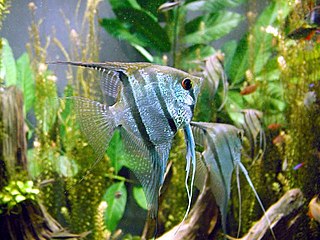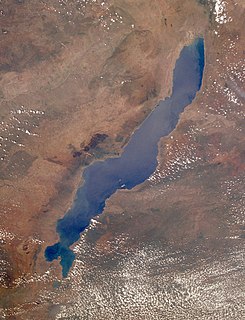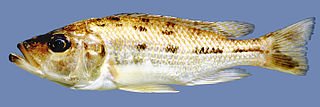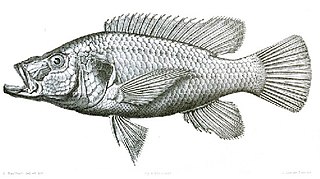
Cichlids are fish from the family Cichlidae in the order Cichliformes. Cichlids were traditionally classed in a suborder, Labroidei, along with the wrasses (Labridae), in the order Perciformes but molecular studies have contradicted this grouping. The closest living relatives of cichlids are probably the convict blennies and both families are classified in the 5th edition of Fishes of the World as the two families in the Cichliformes, part of the subseries Ovalentaria. This family is both large and diverse. At least 1,650 species have been scientifically described, making it one of the largest vertebrate families. New species are discovered annually, and many species remain undescribed. The actual number of species is therefore unknown, with estimates varying between 2,000 and 3,000.

Lake Malawi, also known as Lake Nyasa in Tanzania and Lago Niassa in Mozambique, is an African Great Lake and the southernmost lake in the East African Rift system, located between Malawi, Mozambique and Tanzania.

Lake Tanganyika is an African Great Lake. It is the second-oldest freshwater lake in the world, the second-largest by volume, and the second-deepest, in all cases after Lake Baikal in Siberia. It is the world's longest freshwater lake. The lake is shared between four countries – Tanzania, the Democratic Republic of the Congo (DRC), Burundi, and Zambia, with Tanzania (46%) and DRC (40%) possessing the majority of the lake. It drains into the Congo River system and ultimately into the Atlantic Ocean.

Labidochromis caeruleus is a species of cichlid endemic to the central western coastal region of Lake Malawi in East Africa. It is also known as lemon yellow lab, the blue streak hap, the electric yellow or yellow prince, depending on the colour morph. A naturally occurring yellow-coloured variant from Lion's Cove is one of the most popular cichlids amongst aquarium hobbyists.

Astatotilapia is a genus of small freshwater fish in the family Cichlidae found in Eastern and Northern Africa, with a single species, A. flaviijosephi, in Western Asia. Many species have been moved between this genus and Haplochromis, and while some consensus has been reached in recent years, their mutual delimitation is still far from settled. Based on mtDNA, Astatotilapia as currently defined is polyphyletic.

The haplochromine cichlids are a tribe of cichlids in subfamily Pseudocrenilabrinae called Haplochromini. This group includes the type genus (Haplochromis) plus a number of closely related genera such as Aulonocara, Astatotilapia, and Chilotilapia. They are endemic to eastern, southern and northern Africa, except for Astatotilapia flaviijosephi in the Middle East. A common name in a scientific context is East African cichlids – while they are not restricted to that region, they are the dominant Cichlidae there. This tribe was extensively studied by Ethelwynn Trewavas, who made major reviews in 1935 and 1989, at the beginning and at the end of her career in ichthyology. Even today, numerous new species are being described each year.

Nimbochromis livingstonii, Livingston's cichlid or (locally) kalingono, is a freshwater mouthbrooding cichlid native to Lake Malawi, an African Rift Lake. It is also found in the upper Shire River and Lake Malombe. They are found in inshore areas of the lake over sandy substrates.

Rhamphochromis is a genus of East African haplochromine cichlids endemic to the Lake Malawi basin, including the main lake, Lake Malombe, Lake Chilingali, Chia Lagoon and upper Shire River. They mainly occur in offshore open waters, but a few species also near the coast. They are piscivores that typically feed on lake sardines and small utaka cichlids.

Hemitaeniochromis urotaenia is a species of fish endemic to Lake Malawi in East Africa. It is the type species of the genus Hemitaeniochromis, and is part of family Cichlidae in subfamily Pseudocrenilabrinae and the tribe Haplochromini.

Astatotilapia burtoni is a species of fish in the family Cichlidae.

Astatotilapia desfontainii is a species of cichlid found in Algeria and Tunisia. It is found in freshwater spring, irrigated land, and canals and ditches. It is threatened by habitat loss. This species reaches a length of 15 centimetres (5.9 in) TL.
Astatotilapia flaviijosephi, the Jordan mouthbrooder, is a vulnerable species of freshwater fish in the family Cichlidae (cichlids). It is found in the central Jordan River system, including Lake Tiberias (Kinneret), in Israel, Jordan and Syria, making it the only haplochromine cichlid to naturally range outside of Africa. This species is too small to be of significant importance to fisheries, unlike the only other cichlids native to the Levant, the economically important tilapias.
Astatotilapia paludinosa is a species of cichlid endemic to Tanzania where it is found in the lower Malagarasi River and the surrounding swamps. This species can reach a length of 14 centimetres (5.5 in) SL.
Astatotilapia tweddlei is a species of fish in the family Cichlidae. It is found in Malawi and Mozambique. Its natural habitats are rivers and freshwater lakes.
The striped nothobranch is species of freshwater fish of East Africa, belonging to the family Aplocheilidae.

Tristramella is a genus of oreochromines, freshwater fishes in the cichlid family. The members of this genus prefer standing waters and their native range is restricted to the Jordan River system, including Lake Tiberias (Kinneret), in Israel and Syria, with introduced populations in a few other places in Syria. Its members are among the few cichlids native to Western Asia, the others being Astatotilapia flaviijosephi, Coptodon zillii, Iranocichla, Oreochromis aureus, O. niloticus and Sarotherodon galilaeus.

The redbelly tilapia, also known as the Zille's redbreast tilapia or St. Peter's fish, is a species of fish in the cichlid family. This fish is found widely in fresh and brackish waters in the northern half of Africa and the Middle East. Elsewhere in Africa, Asia, Australia and North America, it has been introduced as a food fish or as a control of aquatic vegetation. Where introduced, it sometimes becomes invasive, threatening the local ecology and species. The redbelly tilapia is an important food fish and sometimes aquacultured.

Astatotilapia bloyeti is a species of haplochromine cichlid from the coastal river systems of Tanzania. Reports from other areas of Africa are considered to refer to related species. The IUCN considers it to be endemic to the Pangani River and includes Kenya in its range. This species taxonomic status is uncertain and some authorities place it in the genus Haplochromis while others retain it in Astatotilapia. This taxonomic uncertainty has led the IUCN to classify this species conservation status as Data Deficient. The specific name honours the collector of the type, Capitaine A. Bloyet, chief of the French research station at "Kandôa, Tanzania".

Astatotilapia calliptera, the eastern happy or eastern river bream, is a species of haplochromine cichlid from southeastern Africa.
Astatotilapia swynnertoni is a species of haplochromine cichlid which is found in the rivers of Mozambique from the Buzi and lower Pungwe rivers south to the Save River. The specific name honours the English naturalist Charles Francis Massy Swynnerton (1877-1938) who discovered the type on his farm in Mozambique.















